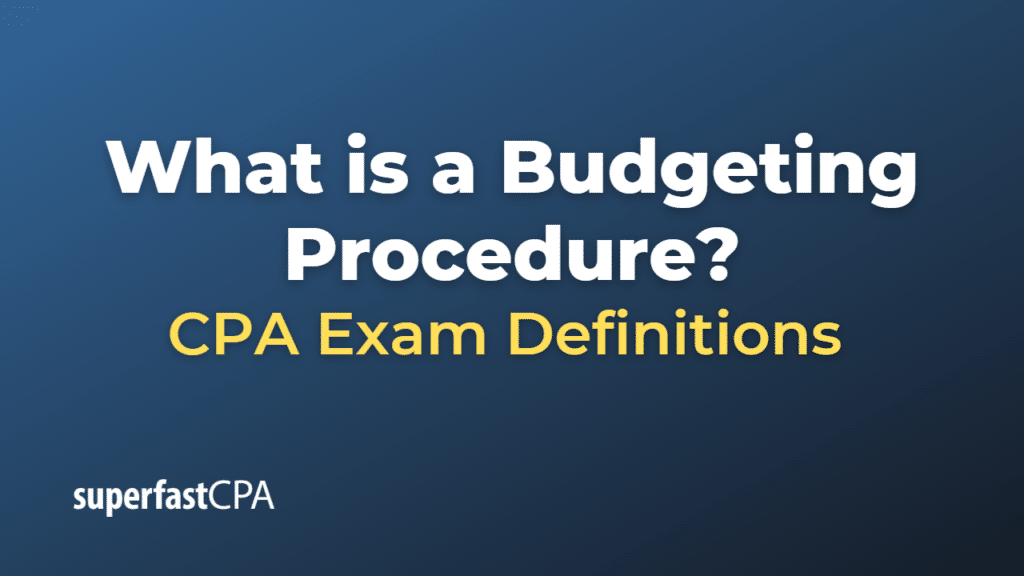Budgeting Procedure
A budgeting procedure is a systematic process used by organizations to plan, develop, implement, and monitor their financial plan for a specific period, usually a year. The procedure involves setting financial objectives, estimating income and expenses, and allocating resources to achieve the organization’s goals. The budgeting procedure helps businesses control their finances, make informed decisions, and evaluate their financial performance.
Here are the typical steps involved in a budgeting procedure:
- Set financial objectives: Begin by defining the organization’s financial goals for the budget period, such as increasing revenue, reducing costs, or improving profitability.
- Gather historical data and information: Collect data from previous financial statements, departmental reports, and other relevant sources to establish a baseline and identify trends.
- Develop revenue and expense projections: Estimate the organization’s income and expenses for the budget period based on historical data, market trends, and management’s expectations.
- Allocate resources: Allocate resources, such as funds, personnel, and equipment, to various departments or activities based on their priorities and the organization’s goals.
- Prepare the budget: Consolidate the revenue and expense projections, and resource allocations into a comprehensive budget document that outlines the organization’s financial plan for the budget period.
- Review and approve the budget: Have the budget reviewed by relevant stakeholders, such as department heads or the board of directors, and make any necessary adjustments before final approval.
- Implement the budget: Communicate the approved budget to all relevant personnel and start executing the financial plan.
- Monitor and control the budget: Regularly track actual revenues and expenses against the budget, identify variances, and take corrective action as necessary to ensure the organization stays on track to achieve its financial objectives.
- Evaluate and adjust the budget: Periodically evaluate the budget’s effectiveness, and make adjustments as needed to address changes in the organization’s circumstances or goals.
- Report on budget performance: Prepare financial reports comparing actual performance to the budget, and share the results with stakeholders to ensure transparency and accountability.
By following a structured budgeting procedure, organizations can create a realistic and achievable financial plan that helps them manage their resources effectively and work towards their financial goals.
Example of a Budgeting Procedure
Let’s consider a small business that manufactures and sells handmade soaps as an example of a budgeting procedure:
- Set financial objectives: The business owner sets a goal to increase net profit by 15% over the next year.
- Gather historical data and information: The owner analyzes the previous year’s financial statements, sales data, and expense reports to understand the business’s past performance.
- Develop revenue and expense projections: Based on the historical data and current market trends, the owner projects a 10% increase in sales revenue and a 5% increase in the cost of raw materials for the next year.
- Allocate resources: The owner decides to allocate additional funds towards marketing efforts to boost sales and allocates funds for hiring one more employee to support production.
- Prepare the budget: The owner prepares a detailed budget outlining the projected revenues, expenses, and resource allocations for the next year.
- Review and approve the budget: The owner reviews the budget with their accountant, who provides feedback and suggests minor adjustments to improve its accuracy.
- Implement the budget: The owner communicates the approved budget to the production manager and marketing team, so they can plan their activities accordingly.
- Monitor and control the budget: Throughout the year, the owner tracks actual revenues and expenses, comparing them to the budget and identifying any variances that require corrective action.
- Evaluate and adjust the budget: Halfway through the year, the owner realizes that the sales are growing faster than expected. They decide to adjust the budget, increasing the marketing budget and raw materials allocations to support the higher demand.
- Report on budget performance: At the end of the year, the owner prepares a financial report comparing the actual performance to the original and adjusted budgets. They share this report with their accountant and any potential investors to demonstrate the business’s financial progress and accountability.
By following a structured budgeting procedure, the small business owner can make informed decisions, allocate resources effectively, and monitor their progress towards achieving their financial objectives.













